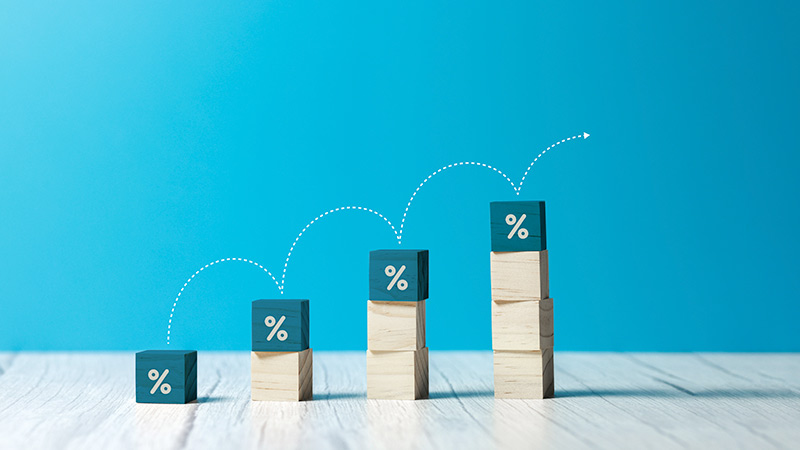
This content is for information and inspiration purposes only. It should not be taken as financial or investment advice. To receive personalised, regulated financial advice please consult us here at Elmfield Financial Planning in Padiham, Burnley, Lancashire.
You have likely noticed that prices are going up in 2022. At some supermarkets, for instance, the cost of pasta and tinned tomatoes has risen by as much as 41% compared to a year ago. The average price for standard range spaghetti in 2021 was 51p, whilst now it stands closer to 72p. Inflation – i.e. the overall rise in prices for goods and services in an economy – is going up, and many people are wondering how this will affect their wealth and finances in 2022.
Below, our team at Elmfield (financial planners in Padiham, Burnley, Lancashire) offer this short guide on the current stage of inflation, where things might go and how you can prepare your financial plan. We hope this is helpful to you. If you’d like to speak to an independent financial adviser then you can reach us via:
T: 01282 772938
Why is inflation going up?
Since 1997, the Bank of England (BoE) has been charged with the responsibility of keeping UK inflation under control. It has a target of 2% per year – widely seen as a “healthy” rate which lets the economy grow without prices spiralling out of reach of consumers. By and large, the BoE has kept UK inflation close to this target since 2015. However, since summer 2021 the UK has seen a rise in the cost of living. In August the CPI (Consumer Price Index) stood at 3.2% as the nation started emerging from months of Covid lockdown. By October, however, inflation rose to 4.1%. Today, writing in March 2022, the latest figures stand at 5.4%.
A number of reasons have been given to help explain the rise. One plausible reason is that the UK saw a surge in highstreet spending as COVID-19 restrictions started easing in 2021. This led to more people spending money on clothes, eating out and commuting. Another big factor is the global rise in energy prices in 2021. This led to higher gas and petrol bills for consumers, and higher input costs for businesses (e.g. supermarkets relying on lorries for food deliveries) – which then often passed on the costs to customers.
The road ahead
Inflation was initially thought by the BoE and the UK Government to be “transitory” as the world economy re-opened. However, as we entered 2022, it became clear that higher inflation was here to stay for a while. Ofgem – the UK’s energy regulator – had already announced a 12% rise to the energy price cap in October 2021. More recently, a further 54% rise is planned in April 2022 – meaning millions of households could see their annual bills go up by £693. Further rises later in the year are also possible.
The Ukraine-Russia conflict – which erupted in late February – is likely to make things worse for global energy prices. Russia is a huge exporter of oil and gas to Europe, and western sanctions over the invasion could drive prices higher as these choke Russia’s exports. Whilst we all hope for an early resolution to the conflict (especially for civilians affected), it is likely that the conflict could drag on for many months and cause economic disruption along the way.
In 2022, we all need to be prepared for a year – or longer – of higher prices.
How this affects your financial plan
Naturally, higher prices in the UK economy mean greater pressure on your monthly budget as your weekly food shop, petrol and other costs likely go up. You can mitigate these, to an extent, by changing your budget. Perhaps you walk/cycle more to work for your commute, rather than taking the car. Maybe you could alter your meal plan so you buy fewer supermarket items which have risen in price. You might also invest in making your home more energy-efficient, to mitigate the impact of rising energy prices (and do something good for the environment!).
However, there are also longer-term implications for your financial plan to consider. Inflation is often called the “silent killer” of savings, since it erodes the spending power of your money over time. As such, if you have large amounts of cash put away in regular savings accounts, it may be time to consider putting this to better use. Bear in mind that it is hard to find a regular savings account in 2022 which beats 1%. With inflation currently at 5.4%, this represents a 4.4% “real loss” on the value of your cash over time – even if your bank statement might show that you have “earned more” money by generating interest.
A good rule of thumb is to aim for 3-6 months of living costs in an easy-access cash account, to tide you over during hard times (e.g. redundancy, or a family emergency). After that, consider other assets which might give you a better return. Here, you will need to factor in your financial goals, investment horizon and risk tolerance before committing to a portfolio. A financial planner can help you work through these considerations and build an informed investment strategy.
Invitation
If you are interested in starting a conversation about your own financial plan or investments, then we’d love to hear from you. Please contact us to arrange a free, no-commitment consultation with a member of our team here at Elmfield Financial Planning in Padiham, Burnley, Lancashire.
Reach us via:
T: 01282 772938

